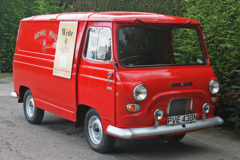Leyland Reiver returns
Posted by Chris Graham on 16th January 2020
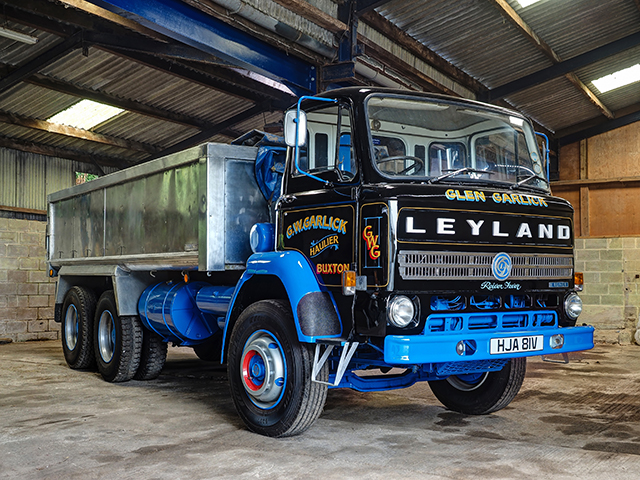
Five years ago, Andrew Garlick sold this 1976 Leyland Reiver after ten years of ownership; a decision he soon regretted. Last year, however, his 21-year-old son, Glen, bought it back and carried out a full restoration. Peter Simpson tells the story.
One of the biggest ‘issues’ facing the historic vehicle movement at present seems to be how to attract younger people to join. However, with one well-known Derbyshire family at least, it seems the next generation is every bit as enthusiastic, as this Leyland Reiver tale illustrates. Regular readers will already be familiar with the Garlicks, as we featured their 1985 Leyland Constructor in our January 2018 issue. This lorry, as many of you will no doubt recall, was bought by the family in 1994 and used by them commercially on quarry/stonework for almost twenty years prior to being restored and ‘preserved’.

Father and Son: Andrew (left) and Glen Garlick
In that piece we also introduced Glen Garlick, the 4th generation of the family to work in the haulage industry. Now aged 21, Glen started driving lorries as soon as he was 18, taking his Class 2 test in 2016, followed by his Class 1 in 2017. His first job on leaving school was with local company Hazelcrofts working in the garage. Then, with his LGV licence in his hand, he went to Woods Plant Hire of Buxton. He subsequently returned to Hazelcrofts where he now drives an eight-wheeled tipper or tarmac and stone haulage from the various quarries around Buxton to places like Manchester, Cheshire, Sheffield; in fact he goes “pretty much anywhere that’s within a day there and back.”
Lorries, however, are far more than just a job for Glen. Having, basically, grown up surrounded by them it is, totally in his blood. He drove the Constructor – a lorry that has been part of the family since before he was born – on our photoshoot last year, and it was also clear from meeting and talking to him then that he was every bit as enthusiastic about lorries, Leylands, and lorry preservation in general, as his Dad. It is therefore perhaps no surprise that Glen now has a preserved lorry of his own. What’s more, it’s another Leyland with strong Garlick family connections and one of which he has many growing-up memories.
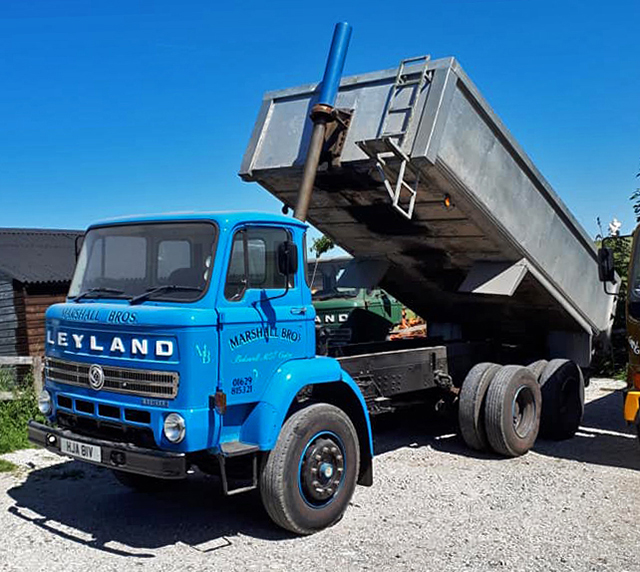
As acquired by Glen Garlick in June 2018, from the family his father had sold it to four years earlier
Back in 2004, when Glen was just six years old, Andrew had bought the 1976 Leyland Reiver featured here. However for various reasons ten years later in 2014 – when Glen was 16 – it was sold.
Made in ‘76, registered ‘79
We’ll come back to that in a moment though. First, though, a little about this Reiver’s rather unusual pre-preservation history. It was bought new, in 1976, by the Gibling Brothers of Burnage, Manchester. It wasn’t, however, road-registered until 1979 (hence the V registration) and is not thought to have been used by the Giblings at all, being sold by them in 1987 as a ‘new’ 11 year old lorry. Why this happened is a total mystery, though a (legal) loss for tax purposes has been suggested. Mechanical specification included a Leyland 410 turbo engine, six-speed non-synchro gearbox and Albion back axles.
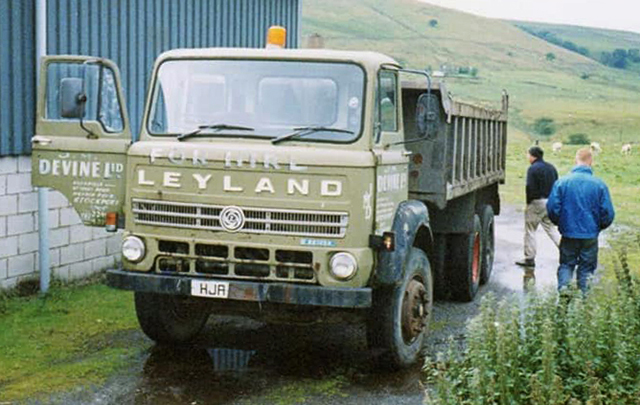
The Reiver in the livery of John Devine who, though its second owner, was the first to actually use it
The second owner was a John Devine who replaced the alloy body with one of steel construction and used the Reiver for ‘muck shifting’ from pavements etc., under contract to Stockport Council. After that it moved a few miles north to a farmer based near Oldham where it was used on general farm haulage work before being ‘rescued’ for preservation by Paul Parker and John Murphy from whom Andrew Garlick bought it in 2004.
Andrew then carried out what he describes as a “light restoration” involving a little welding to the cab followed by a repaint. He also “went right through” the brakes, carried out a full mechanical service and fitted another alloy body that had been taken from a family-owned Leyland Constructor.
Thus restored, the Reiver was rallied for many years, and of course it was the ‘shows’ lorry which Glen grew up with and rode in. However in 2014, with various other lorries around, the Reiver was sold to Ian and Sean Marshall – a father and son team in Bakewell. After repainting the Reiver in their livery, they rallied it for a couple of years until they had to stop for health reasons.
By now, Glen was of course grown up and taking a very active interest in lorry preservation. He also rather fancied owning one of his own, and given that a family lorry that he knew so well didn’t seem to be doing much, contact was made, and a return to Garlick family ownership agreed. This time, though it was Glen, rather than Andrew, who was the owner. The baton was passing to the next generation; Dad Andrew helped out a lot with advice and a certain amount of hands-on involvement where required, but the Reiver now very definitely belongs to, and is controlled by, Glen!
The Reiver was “fetched back” on June 22 2018 – which happened to be Glen’s Mother Louise’s birthday and she was not, apparently, especially impressed by that timing! Though it still looked pretty good superficially, the Reiver was by now in need of a second, and rather more extensive, restoration…
Body off by JCB
Work started on July 1 in the yard area behind the Garlick’s home. The first job was to remove the body; a Mk1 JCB provided the lift after which the body was supported on drums and wood and the chassis-cab unit driven out from underneath.
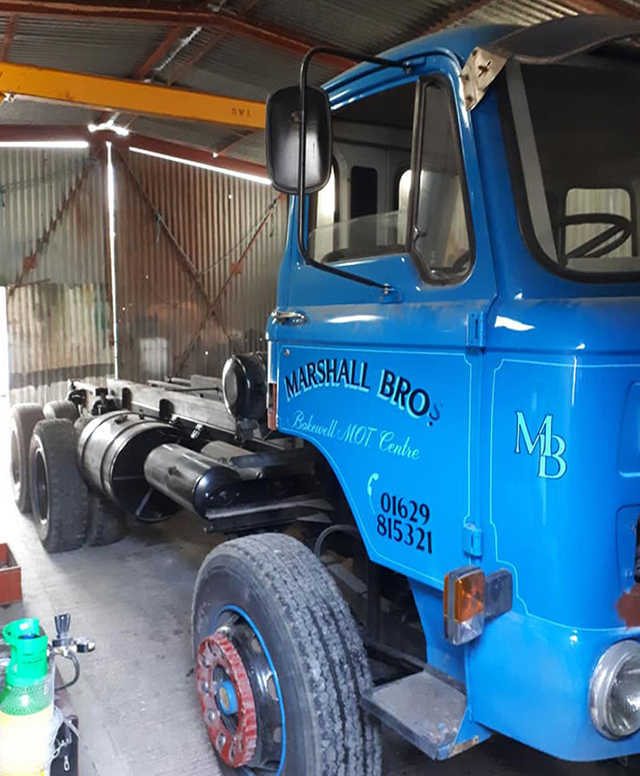
The tipping body was removed, together with the wings, allowing the cab repairs to begin
Work then started on the cab. The wings were stripped off which confirmed that, as Glen and Andrew were half-expecting, the cab’s rear corners contained lots of rot, and there was also extensive corrosion in the outer ends of the cab’s main crossmember. All this was cut out, and new steel sections shaped up and welded in to replace it.
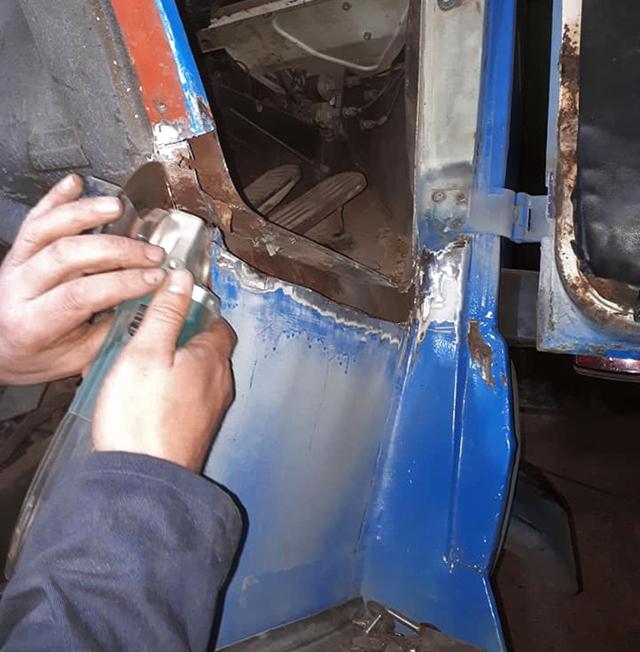
This started as a tiny hole but, as usually happens, it spread quickly once cutting commenced
More localised welded repairs were also needed in the cab floor around the driver’s seat attachment along with some tidying up to the metalwork immediately under the windscreen. The driver’s door was very rusty, however a replacement came with the lorry with, interestingly, Hoveringham Gravel signwriting.
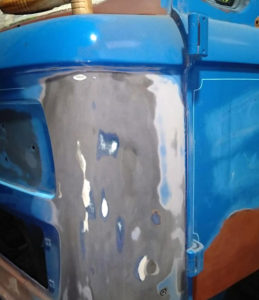
With the cab fully repaired, prepping and painting work could begin then…
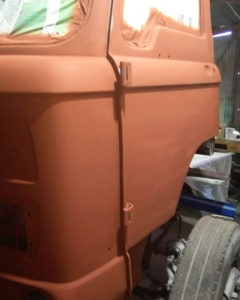
… the entire cab was covered in red oxide
Attention then turned to the chassis which was stripped and then separated down to its component parts to remove corrosion and get everything thoroughly cleaned up. All the suspension bushes were “slightly worn” and renewed along with the wheel bearings and hub seals and 15 years after his Dad had done the same thing in 2004, Glen went right through the braking system, overhauling and renewing as required.
In the club
As we mentioned when we reported on Andrew’s Constructor, the Garlicks are members of an unofficial ‘lorry club’ all of whom store lorries at local enthusiast Steve Fletcher’s premises and meet up there. As is usual in lorry preservation, the ‘members’ help each other out with parts and practical assistance. Several components that went into the Reiver were acquired this way, Steve Fletcher himself supplying a set of spring shackles, while the Garlicks themselves had a set of new kingpins “sat in a cupboard”. New tyres were also fitted all round, and the steering ram needed repair followed by adjustment and setting-up. No work was needed on the engine, gearbox and axles beyond the usual thorough service, oils change and clean-up.
Work then returned to the cab, specifically the interior which was fully stripped out and painted, and a good floor mat sourced and replaced. The seats installed at present are not the originals but have been “borrowed” from the next project, however the originals will be restored and reinstated in due course.
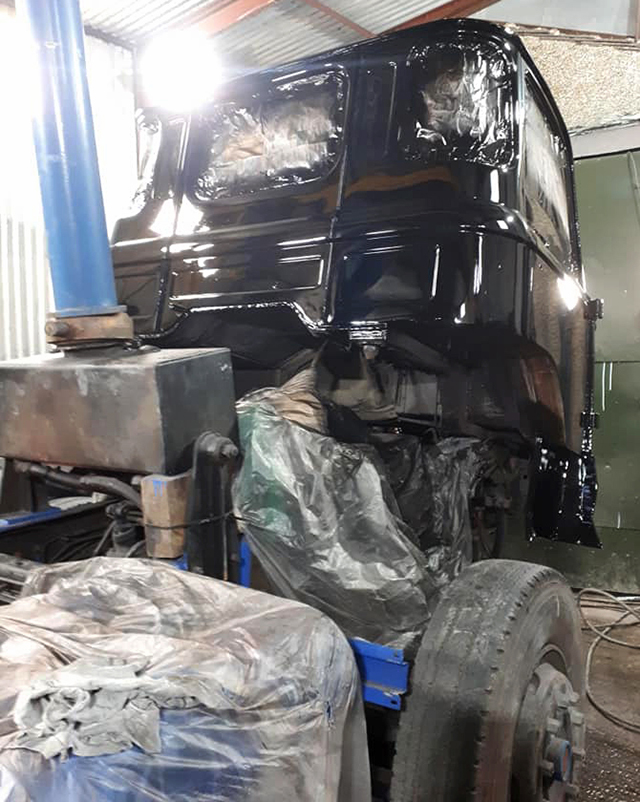
the cab received its colour coat courtesy of Glen’s uncle, Brent Coupe
When it came to painting, Dad Andrew did the chassis and wings, but the main cab paintwork was undertaken by his brother-in-law Brent Coupe who also worked on the Constructor and now “does all the Club Cabs.” This work was undertaken in what Glen describes as a “tin shack” behind the family home, but as the photos show, it came out very well indeed. As with the Constructor, the signwriting was done by John Etchells who being now well

All the paintwork was finished to a very high standard
into his seventies and officially retired, was at first reluctant to take the job on. Until, that is, he realised that it was a lorry he had done before, at which point he became keen, and as the photos show, he did an excellent job.
That just left the tipper body. This has had a little localised repair followed by a thorough clean and polish but otherwise been left unrestored. Consequently – and deliberately – it has a good used look about it. A new tipping pin was, however, installed when it was refitted and the tipper is, of course, fully operational.
Though this was a very thorough restoration, it was completed within a year. Much of that was, of course, down to Glen’s enthusiasm and hard work, though the fact that the family knew the lorry well and knew Leyland products helped a lot, as of course did the support and encouragement from other members of the “Club”.
Blown turbo bother
By late April 2019, the Reiver was ready for the road again. Its first run out in Glen’s ownership was to the Llandudno Festival over May Day bank holiday weekend. Whilst the event itself was a success (the Reiver can be seen on going round the Great Orme on page 55 of our July 2019 issue) disaster struck on the way back. The turbocharger failed, fortunately without causing any significant collateral damage.

Sadly, the Reiver’s first run out in Glen’s ownership – to Llandudno – ended in turbocharger failure. Kevin Dennis supplied a replacement – with a complete engine attached!
A replacement, however, proved extremely elusive as did an overhaul kit and someone to actually rebuild the unit of parts could be found. Eventually our old friend Kevin Dennis came to the rescue though understandably enough, Glen had to buy a complete 410 turbo engine to get a good turbocharger.
This was, however, fitted quickly so that the Reiver was ready for Kelsall at the end of June. Since then, it’s been to events at Chatsworth and taken part in local shows including the annual Buxton Carnival where the latest (re)addition to the Garlick collection went down extremely well.
So there we are. This, lorry however, represents rather more than another restored lorry on the show circuit. It is also a first restoration by a young and extremely keen owner, and while experienced assistance has been on tap, that is the way most people learn how to do things. Glen did most of the work himself, and the standard he has achieved is exceptional. We need more Glen Garlicks!
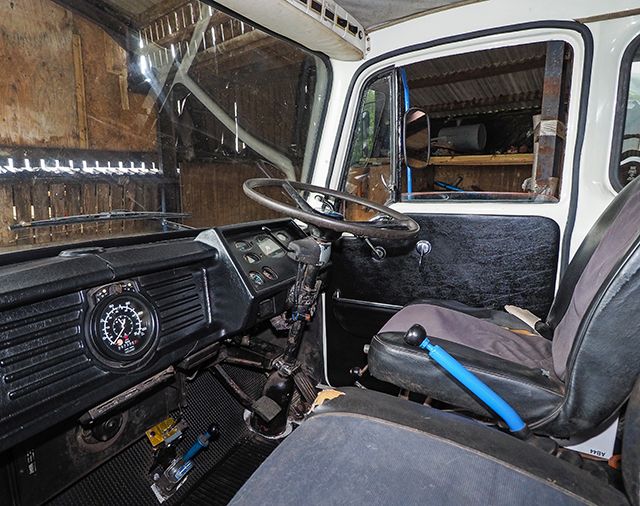
Seats currently fitted are ‘on loan’ from another project; restoration of the originals will follow in due course
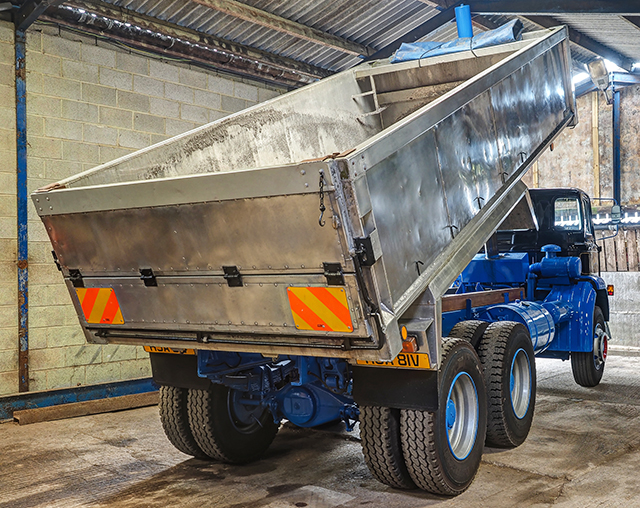
Tipping gear is, of course, fully operational
To subscribe to Classic & Vintage Commercials magazine, click here



